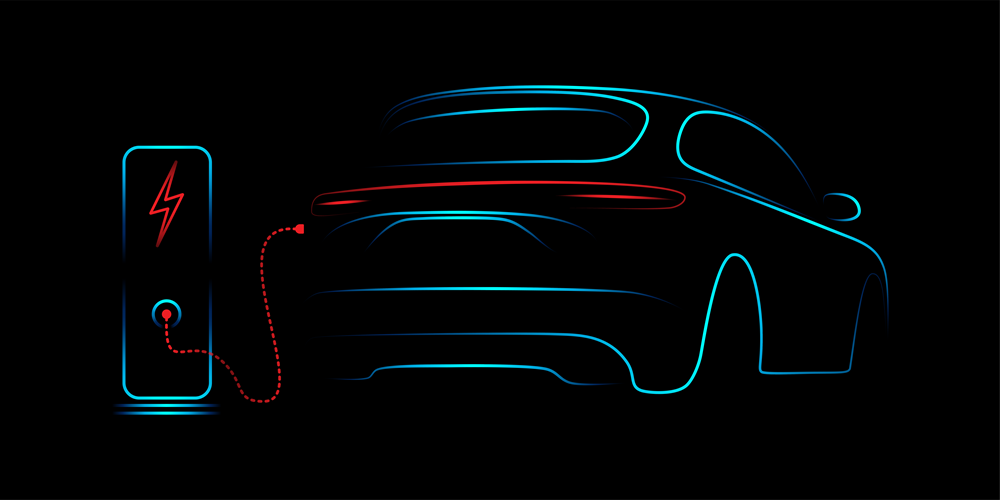
As electric vehicles become more common, people are asking questions about the vehicles and the infrastructure to support them. In preparation for the 2022 Round 6 Federal Highway Administration (FHWA) Alternative Fuel corridor submission, Broward Metropolitan Planning Organization (MPO) staff identified several questions being asked by municipal partners, transportation stakeholders, and residents. The MPO as a coordination agency, quickly developed an “Electric Vehicle Basics” website to help answer frequently asked questions. This summary of important information is available as a resource to the community. Next year, MPO staff will embark on a Countywide Electric Vehicle Master Plan to help plan the future implementation of charging infrastructure and help to guide federal funding.
Changing Climate
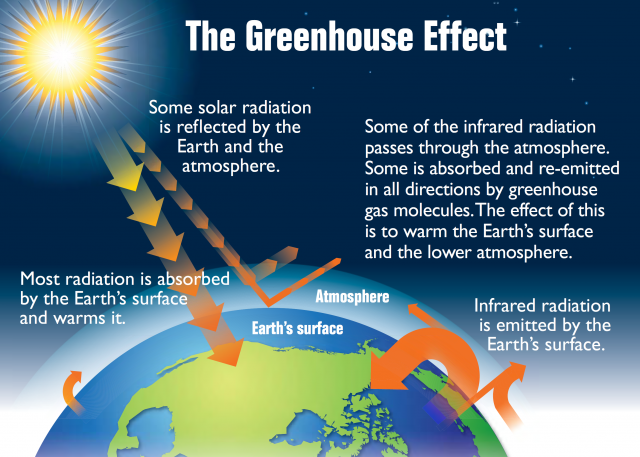
The Environmental Protection Agency (EPA) (https://www.epa.gov/climatechange-science/basics-climate-change) cites multiple lines of evidence that show changes in the climate are ongoing, and causing negative impacts around the world. Shifts in temperature and precipitation patterns, increased ocean temperatures, sea level rise, and more frequent extreme weather events all wreak havoc on a global scale. An unpredictable and changing climate brings with it threats to society, our ways of living, and even the existence of many plants/animal species, and ecosystems.
The key driver of climate change is the greenhouse effect. Energy from the sun enters the Earth’s atmosphere and is trapped by greenhouse gases, storing warmth in the air. The amount of greenhouse gases (GHG) in the atmosphere determines the amount of energy trapped. Evidence shows that since the industrial revolution, GHGs have increased due to human activity. The reduction of the release of GHG into the air, and the potential to capture the gases from the atmosphere and store them permanently, is critical in slowing down the adverse impacts of climate change.
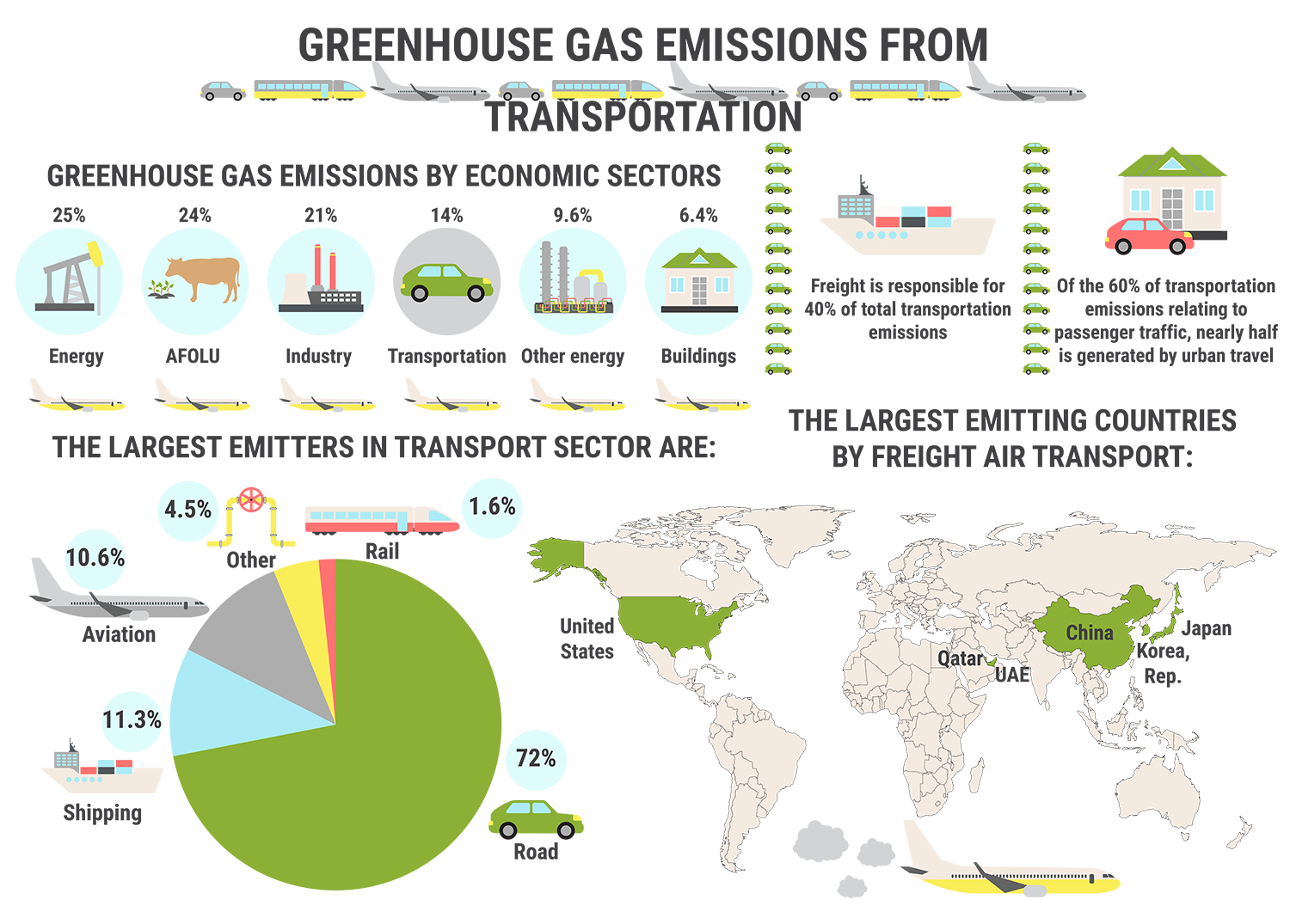
How EVs use energy more efficiently
How are EVs better for the environment than regular cars when most of the electricity is produced by the burning of fossil fuels? The answer lies in the efficiency of electric motors to move the vehicle. Electric cars are 85 to 90% efficient, meaning output produces nearly as much energy as it consumes. In comparison, gasoline powered cars only have a 17 to 21% efficiency; about one-fifth of the energy contained in the gasoline produces power.
Power plants are also more efficient than gas engines at using fuel to create electricity. With the adoption of renewable energy sources such as wind and solar, over time, the nation’s electrical grid will evolve in tandem with electric vehicles to be less-polluting. Adoption of electric vehicles is one part of a bigger plan to respond to climate change in the U.S. Effort to reduce GHG emissions relies on many changes to the nation’s interdependent energy system.
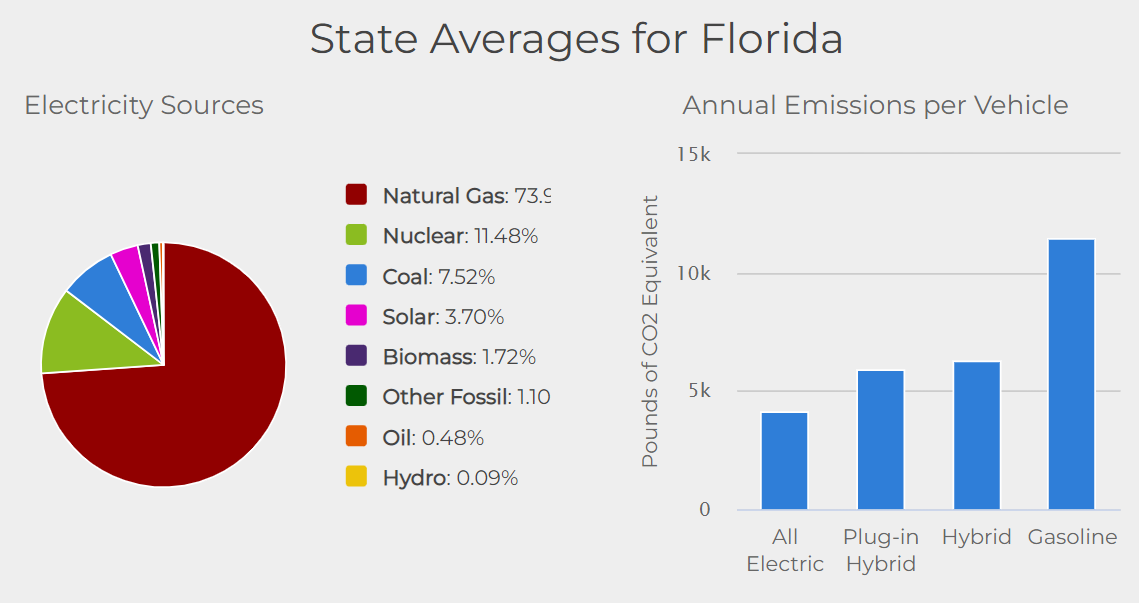
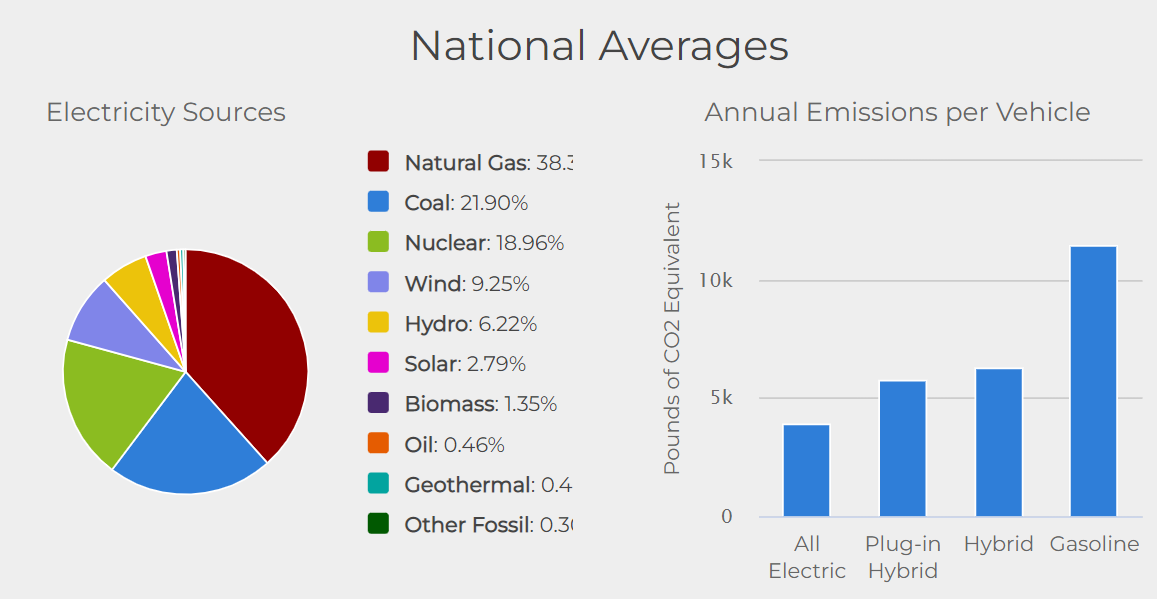
While EVs are more efficient and produce less CO2, there are several environmental impacts that come with battery production. Mining slags, tailings and smelting point-source and surrounding environmental quality issues like water use redirected from communities with historical uses and needs during mining, as well as environmental and human rights issues to name a few. As with anything there are costs and benefits that need to be weighed and considered.
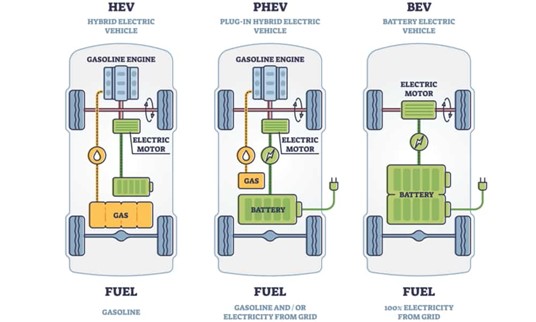
There are three types of vehicles on the market today that use some type of electric motor: hybrid vehicles (HEV), plug-in hybrid electric vehicles (PHEV), and battery electric vehicles (BEV). All three vehicle types emit less climate change-causing greenhouse gases than traditional gasoline-powered cars with internal combustion engines and can benefit drivers in different ways. The difference between them lies in the way electricity powers them.
Hybrid Electric Vehicles

Hybrid vehicles typically have two motors: a gasoline engine supplied by a fuel tank, and an electric motor powered by a small battery. The electric system powers the car at low speeds. The gasoline engine takes over at higher speeds. A regular hybrid car does not use plug-in technology to charge the battery; rather, the small battery recharges when the gasoline engine takes over, as well as in a process called regenerative braking that captures some of the energy created by the braking force of the car. Hybrid cars enjoy improved fuel efficiency over typical internal combustion cars and emit less carbon dioxide into the atmosphere.
Plug-in Hybrid Electric Vehicles

Plug-in hybrid electric vehicles (PHEVs) are like hybrid vehicles, having both a fuel tank and a battery. However, the battery charges through a plug-in to an electrical outlet. Rather than switching back and forth between systems dependent on speed, the gasoline engine of a PHEV takes over from the electric power only after its battery has run out of charge. This means that most short daily trips and errands can be done on electric power alone, and a driver on a longer road trip has the convenience of using the gasoline-powered engine. According to JD Power, herein lies the main perceived benefit plug-in hybrid electric vehicles have over battery electric vehicles: they eliminate “range anxiety,” a term used to describe drivers’ fears that they won’t have enough electric charge to make it to their destination or nearest charging station.
Battery Electric Vehicles
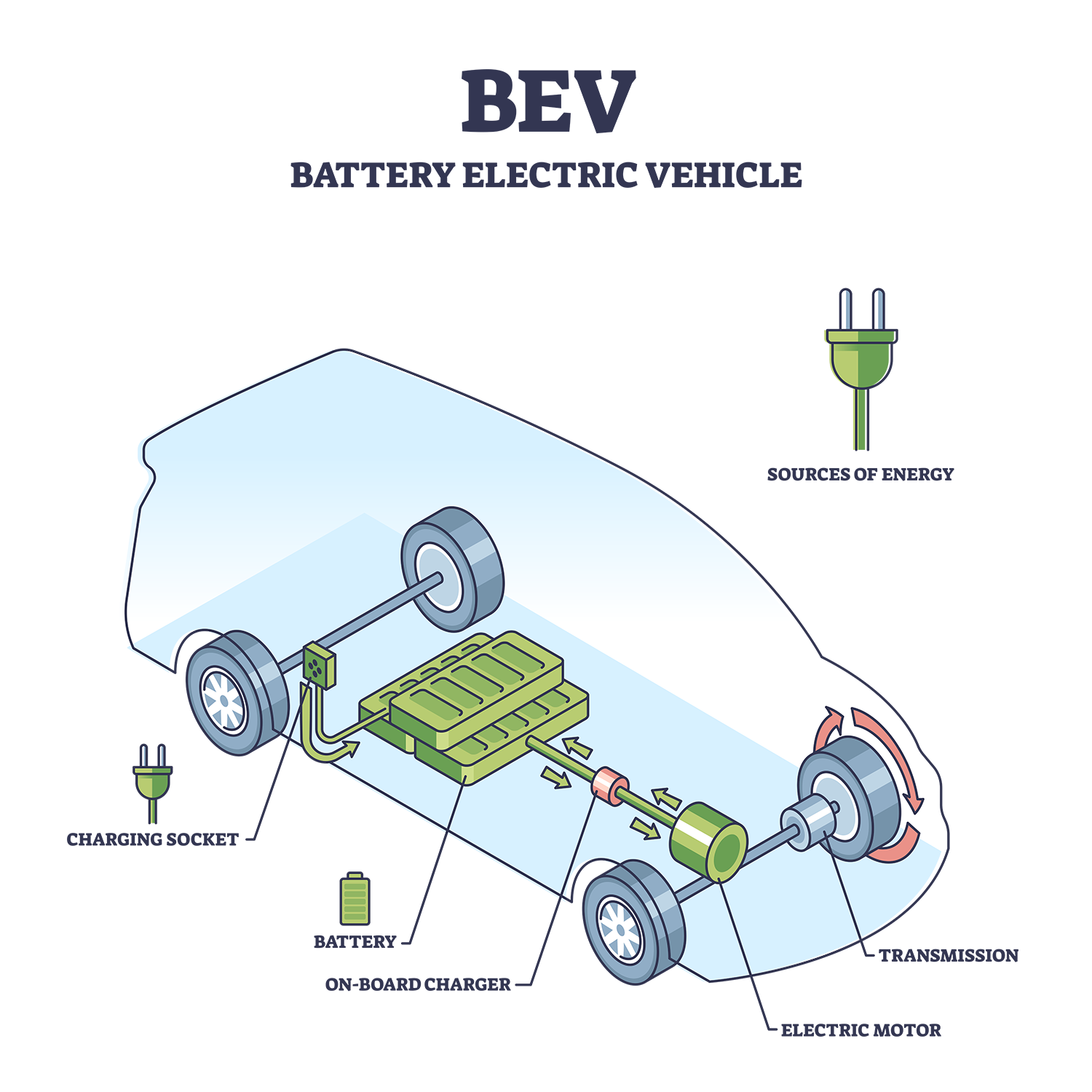
Battery electric vehicles (BEVs) rely 100% on electric power stored in large batteries to power their drivetrains. Their electric-only range is much greater than the electric range of a PHEV, with most new EVs rated for over 200 miles of range on a single charge. And, although electricity production may produce air pollution, the US EPA considers EVs to be zero-emission vehicles because their motors produce no exhaust to emissions.
Electric Vehicle Summary Table
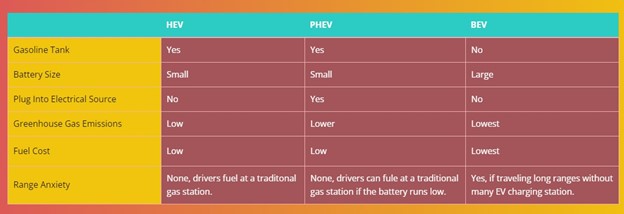
Other Electric Transportation Modes
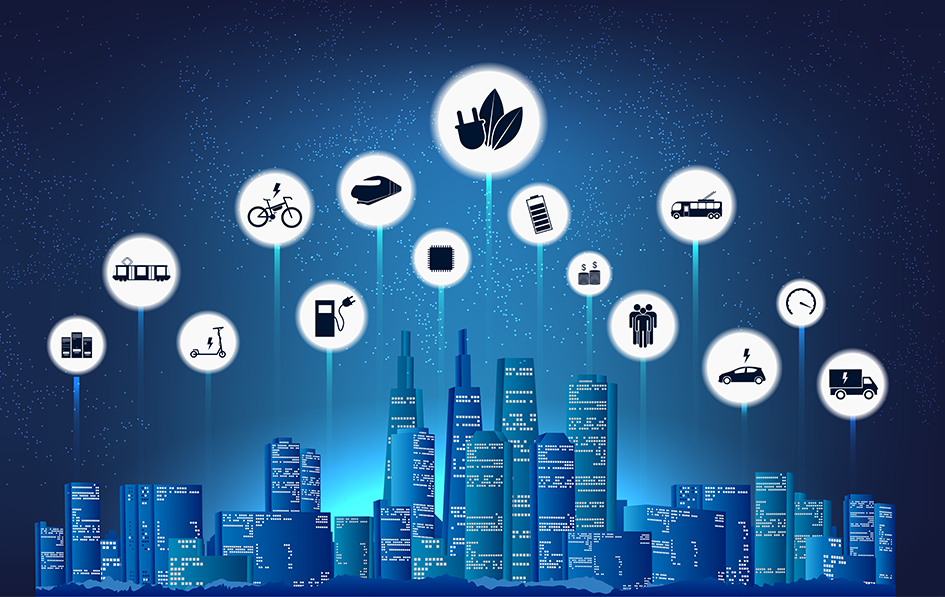
Electrifying the transportation system isn’t all about electric cars. There are many options for clean electric mobility that can work great for travelers and commuters.
According to Bloomberg, electric bicycles have skyrocketed in popularity in the past 5 years, with more e-bikes sold in the US than electric vehicles in 2020 and 2021. Electric bicycles provide riders with electric pedal assistance, requiring less effort to go distances or climb hills and bridges. This assistance can serve the needs of many people, helping bridge the gap for those who might not normally consider using a bike for transportation, such as older riders or those who suffer joint and back pain.
Electric scooters have also proven to be an in-demand product, with sharing services providing convenient options for quick trips around town.
On a larger scale, electric buses used for mass transit and paratransit have begun to replace conventional buses in many public transit agencies’ fleets, as batteries become less expensive, and facilities are retrofitted with charging infrastructure. The electrification of passenger rail systems is also taking place as part of various jurisdiction’s plans to reduce carbon emissions in their transportation systems.
Broward County Transit's new electric buses are now serving passengers!
Broward County Transit Experience Broward County Transit’s New Electric Buses
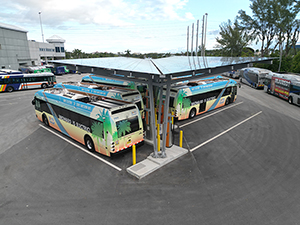
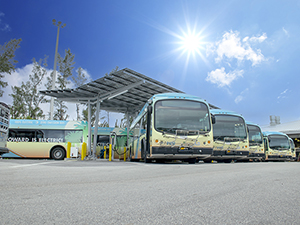
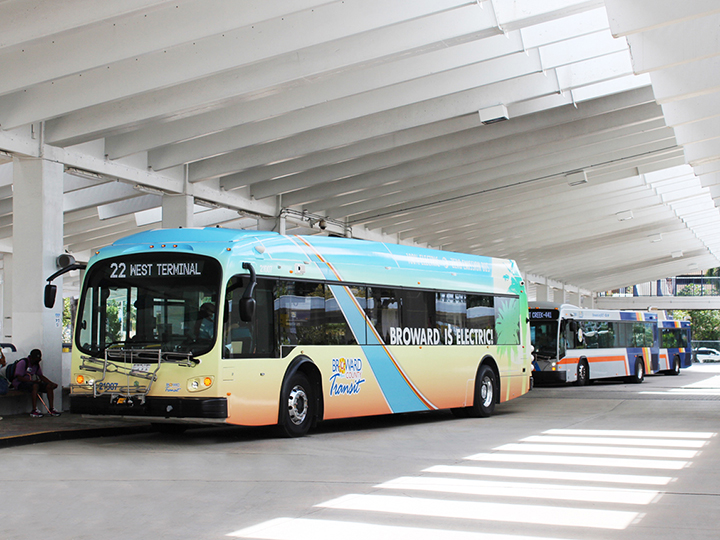

Until recently, electric vehicles were seen by many as prohibitively costly to buy and develop. Car companies and consumers were uncertain of their future potential. But with startups disrupting the industry with innovative new technologies, prices have decreased, and electric vehicles have seen mass-market appeal.
The global Electric Vehicle Market size is projected to grow from 8.1 million units in 2022 to 39.2 million units by 2030, according to a 2022 Market and Markets Electric Vehicle Market Report. https://www.marketsandmarkets.com/Market-Reports/electric-vehicle-market-209371461.html
The uptick in market share is also being expedited by increasing investments by governments across the globe. Several incentives and initiatives have been implemented to encourage the shift. In the United States, the bipartisan Infrastructure Investment and Jobs Act (IIJA) of 2021 significantly increased resources for deploying EV charging infrastructure and upgrades to the electrical grid, as well as established sizable tax rebates for electric vehicles. States and businesses are also offering significant investments, such as subsidies & grants and other various non-direct financial benefits like access to carpool lanes and preferential parking.
In the United States, Florida is #2 in the nation for EV sales, second to California. A Palm Beach Post article from September 2022 noted electric vehicle sales have increased by 56% from July 2021 through June 20222.
Florida offers more than 7,000 public charging ports with over 1,500 direct current fast charging (DCFC) ports.
Broward County
According to data provided by the Florida Department of Highway Safety and Motor Vehicles, there are 5,126 electric vehicles registered in Broward County (based on registrations having no expiration date or expiring on/after August 01, 2022).
Electric Vehicles have the benefit of flexible fueling locations. They can charge at your home overnight or while at your job as you work. There is also the possibility to charge at a public charging station located at a mall or grocery store.
The Biden Administration has set the goal of installing 500,000 charging stations nationwide by 2030. “Making electric vehicle charging accessible to all Americans is critical to achieving a transportation sector that improves our environment, and lessens our dependence on oil and gas,” said U.S. Secretary of Energy Jennifer M. Granholm. With the bipartisan IIJA (passed in November 2021) $7.5 billion dollars was included in supporting and incentivizing the buildout of America’s electric vehicle charging infrastructure.
Florida currently offers more than 7,000 charging ports, with 1,555 being direct current fast charging (DCFC) ports. Using data downloaded from the U.S. Department of Energy in September of 2022, the map below shows the location of over 250 public charging ports in Broward County.
Charger Types
How do battery electric vehicles get power? Like our smartphones and devices, EVs need to be plugged in to be charged. As technology advances, inductive or wireless charging may become a common charging technique. However, there are two primary types of charging currently available, AC (Alternating Current) and DC (Direct Current). AC is the power that comes from the grid itself. The power needs to be converted from AC to DC to charge the battery, and this is done within the car in the onboard converter. The DC power then moves to the battery, providing the "fuel". AC chargers have lower required power range, meaning the charging time will be slower. DC chargers have a converter inside the charger. The car battery will receive a DC current without needing to convert anything inside the vehicle. DC chargers require more power, which means that the charger’s installation and production costs are higher.

Charging Types and Time Source: https://www.evgo.com/ev-drivers/charging-basics/#how-long-to-charge-ev
Level 1 (L1)– Think home charging
Charging an electric car with a Level 1 charger does not require any special equipment. You can plug your car into a regular 120-volt AC plug, though you will need to plug into a dedicated circuit that does not supply electricity to anything else in your house. Nearly all electric vehicles come with a cord that will fit a standard 3-prong outlet and the car. With L1, it will take about an hour of charging time to add a range of 3 - 5 miles to your vehicle. Because of the time needed, most people will charge their car this way when they are at home and overnight. Level 1 charging works well for plug-in hybrid electric vehicles (PHEVs) because they have smaller batteries.
Level 2 (L2)– Think home, work, mall; anywhere the vehicle sits unused for a couple of hours
Level 2 chargers are the most common chargers used for daily charging. They are faster than L1 but require special equipment. With L2, you can get up to 60 miles of range per hour of charging time and can fully charge an empty battery in 4-10 hours. This allows for use in a public or work environment, as vehicles are often parked for extended periods of time.
Funding through the IIJA and other sources might offer incentive programs that can help consumers pay for the cost and installation of Level 2 charging equipment.
Level 3 or DC Fast Charging (DCFC) – Think Road trip
DC Fast charging is much faster than L1 and L2, which makes it preferable for drivers on the go. The fastest speed enables rapid charging along heavy-traffic corridors. DCFC equipment can charge an electric battery up to 80 percent in just 20 minutes to 1 hour. Most EVs have battery management systems to try to blunt any negative effects of DC fast charging on their battery. However, compared to Level 1 and Level 2 charging, DC fast charging can put more strain on batteries.
Plug Types
Regardless of how or where you want to charge your electric vehicle; at home, work, or on the go, one thing is crucial: the cable that connects the charging station with your vehicle must have the right plug on both ends.
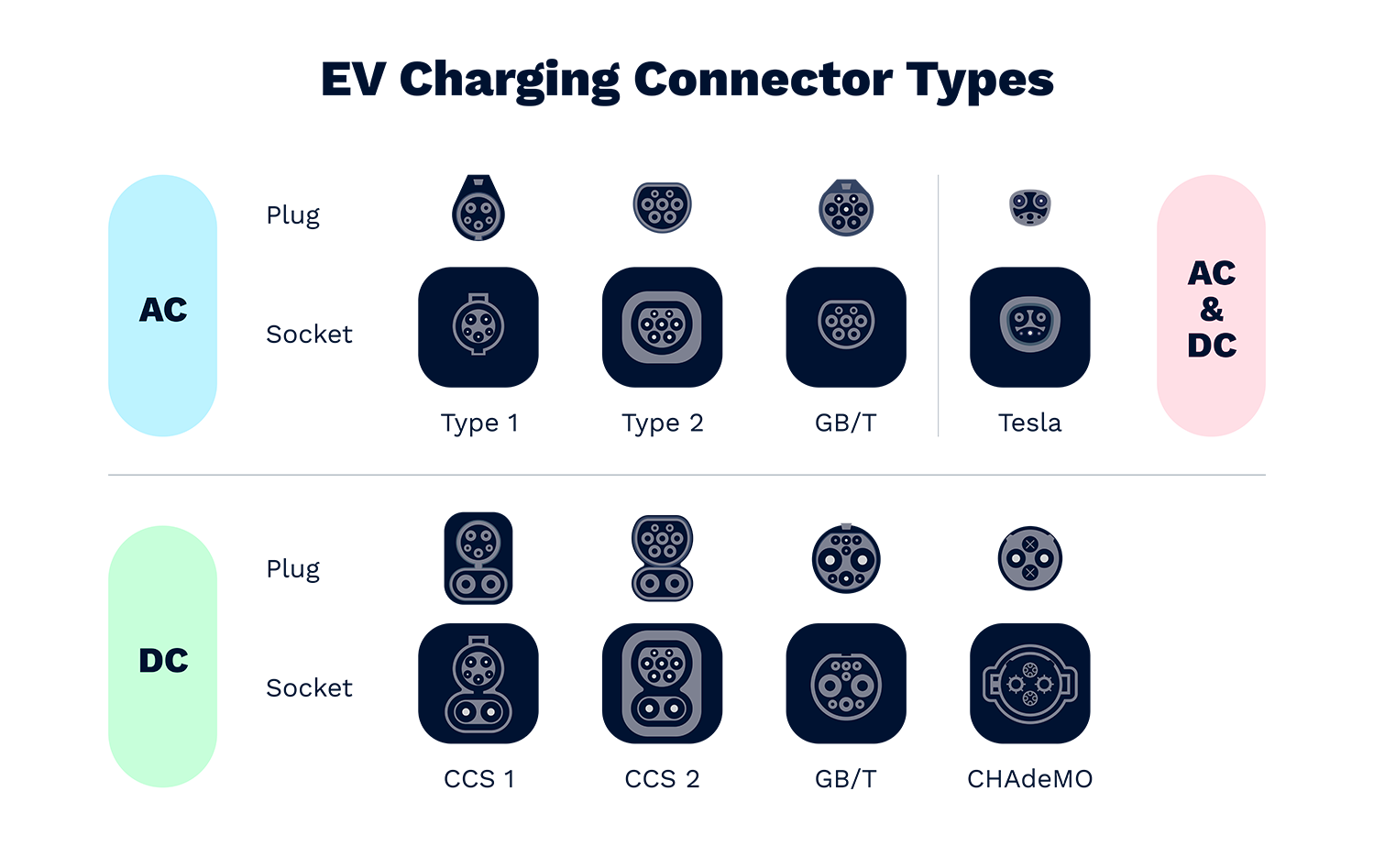
One of the criticisms of electric vehicle adaptation is the lack of stand-charging infrastructure. The use of these different charging standards is a barrier to standardization for EV charging stations. In the US, there are four types of plugs: two for alternating current (AC) and two for direct current (DC). For electric vehicles, the type of plugs required can depend on the manufacturer or county.
Costs for Equipment
Greater and more widespread electric vehicle adoption results in increased needs for charging infrastructure across various locations, including homes, workplaces, and the public. Deploying infrastructure in line with electric vehicle growth is critical to ensure driver convenience and increase confidence and awareness among prospective drivers.
Prices vary from a $0 investment with an L1 charger to over $30,000 with L3. There are incentives as part of the IIJA to help offset the cost as well as private companies offering incentive programs.

Cost for Charging
The fuel efficiency of an EV may be measured in kilowatt-hours (kWh) per 100 miles. To calculate the cost per mile of an EV, the cost of electricity (in dollars per kWh) and the efficiency of the vehicle (how much electricity is used to travel 100 miles) must be known. The U.S. Department of Energy provides the following example; if electricity costs 10.7 cents per kWh and the vehicle consumes 27 kWh to travel 100 miles, the cost per mile is about $0.03.
If electricity costs 10.7 cents per kilowatt-hour, charging an EV with a 200-mile range (assuming a fully depleted 54 kWh battery) will cost about $6 to reach a full charge.
Annual charging costs in Florida for a sample 2022 battery electric vehicle are just 30% of the cost of fuel compared to a similar gasoline-powered version. This also translates to lower greenhouse gas emissions, at 42% of the annual attributable emissions of a comparable internal combustion engine.

In November of 2021, the US Congress passed the Infrastructure Investment and Jobs Act (IIJA), a $7.5 billion, five-year program that incentivizes the buildout of America’s electric vehicle charging infrastructure.
The IIJA establishes two funding programs for new electric vehicle (EV) infrastructure investment: the National Electric Vehicle Infrastructure (NEVI) Formula Program and the Discretionary Grant Program for Charging and Fueling Infrastructure.
To be eligible for funding, EV infrastructure under the NEVI Program and the competitive Corridor Charging Grant Program must be located on a designated Alternative Fuel Corridor.
https://www.fhwa.dot.gov/environment/alternative_fuel_corridors/
National Electric Vehicle Infrastructure (NEVI) Formula Program
$5 Billion
The NEVI formula funds will be provided by the Department of Transportation (DOT) through a state formula grant. Under the program, Federal dollars can be used for the installation, network connection, data sharing, operation, and maintenance of EV charging infrastructure. Formula funding will be allocated to all 50 states, D.C., and territories to support the installation of publicly accessible charging infrastructure and establish an interconnected network for data collection, access, and reliability. The IIJA also requires DOT to set aside 10% of funds for discretionary grants to localities to strategically fill in gaps in the national network.
Discretionary Grant Program for Charging and Fueling Infrastructure
$2.5 Billion
The Charging and Fueling Infrastructure Grants (also known as the Corridor and Community grants) provides competitive grants to states, local governments, metropolitan planning organizations, and other public-sector entities to support the installation of publicly accessible charging infrastructure—or stations for alternative fuels such as hydrogen or natural gas. The IIJA legislation requires at least 50% of these funds to be designated for a community grant program prioritizing rural and low- and moderate-income.
Florida
The Florida Department of Transportation estimates the NEVI Program funds for Florida to be around $198 million over five years to address EV charging needs for passenger vehicles and light-duty trucks. On September 14th, 2022, the Federal Highway Administration (FHWA) approved FDOT's Electric Vehicle Infrastructure Deployment Plan.
